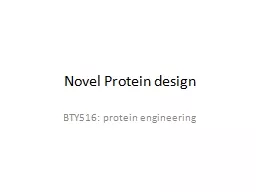

Question Why design novel proteins what can be gained by the design and characterization of novel proteins Can we design 3D protein structures that have never been observed Are the 3D structures that have not been observed in nature unattainable or just ID: 934047
Download Presentation The PPT/PDF document "Novel Protein design BTY516: protein eng..." is the property of its rightful owner. Permission is granted to download and print the materials on this web site for personal, non-commercial use only, and to display it on your personal computer provided you do not modify the materials and that you retain all copyright notices contained in the materials. By downloading content from our website, you accept the terms of this agreement.
Slide1
Novel Protein design
BTY516: protein engineering
Slide2Question
Why design novel proteins?
what can be gained by the design and characterization of novel proteins?
Can we design 3D protein structures that have never been observed?
Are the 3D structures that have not been observed in nature unattainable, or just
unsampled
?
Slide3Main
M
otivations
our understanding of natural proteins--their folding pathways, thermodynamic stabilities, and catalytic properties -- is enhanced (and ultimately tested) by our ability to design novel proteins with predetermined structures and properties.
F
or solving important chemical or biochemical problems.
Slide4STRATEGIES FOR THE DESIGN OF STRUCTURE
Self-Assembly of Modular Units of Secondary Structure
Schematic diagram showing the self-assembly of two peptides into an ordered
dimeric
structure.
End-on view of two parallel (
α
-helices forming a coiled-coil structure. A single
heptad
repeat is shown and the view is looking from the N-terminal end with the a-helices descending into the page.
Slide5Schematic illustration of the incremental approach
STRATEGIES FOR THE DESIGN OF STRUCTURE
Slide62-
Ligand-lnduced
Assembly
STRATEGIES FOR THE DESIGN OF STRUCTURE
Ligand
-induced assembly of a three-helix bundle.
Slide7Schematic diagram showing
ligand
-induced assembly.
2- Ligand-lnduced Assembly
STRATEGIES FOR THE DESIGN OF STRUCTURE
Slide83- Assembly of Peptides via Covalent Cross-linking
Schematic diagram showing the assembly of a structure that is stabilized by
covalent cross-link
STRATEGIES FOR THE DESIGN OF STRUCTURE
Slide9STRATEGIES FOR THE DESIGN OF STRUCTURE
The amino acid sequence and cross-linking pattern of
Chymohelizyme
Slide104- Assembly of Peptides on a Synthetic Template
STRATEGIES FOR THE DESIGN OF STRUCTURE
Schematic diagram of a template-assembled synthetic protein (TASP).
Slide115-Linear Polypeptides That Fold into Globular Structures
STRATEGIES FOR THE DESIGN OF STRUCTURE
Ribbon drawing of the sequence and proposed structure of Felix. The
Cysll-Cys71 disulfide bond is indicated
Slide12Reference
Carey, P.R. (1996). Protein Engineering and Design. Academic Press.
Slide13